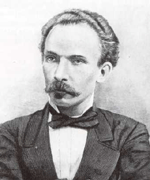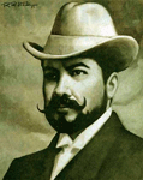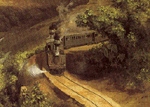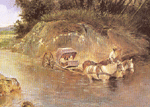Notes on
Latin American Modernismo
1875–1916
During the last quarter of the 19th century and
into the 20th century, there occurred in Latin America
the first major humanities movement that is specifically and uniquely Latin
American. This movement is known as modernismo. This movement
is similar to and overlaps in part with European Modernism, yet it also
diverges from its European counterpart in ways that are characteristic of Latin America. Modernismo
began as a reaction by Latin American intellectuals during the last quarter of
the 19th century to European-style realism and realism's
pseudo-scientific extension, naturalism. Part of the goal of these last to
humanistic tendencies (realism and naturalism) was to educate the public about
social and political problems at the seeming expense of artistic or æsthetic
aspects. The new generation of innovative Latin American humanists promoted the
independence of the humanist himself or herself. For the most part they sought
a social niche in each of their society separate from social activists and
political reformers, yet social commentary is not at all absent from their
works. In literature, the modernistas
campaigned to renew and enrich their prominent international languages
(Portuguese and Spanish) by updating them from the tradition-bound grammars and
vocabularies that had become frozen in the past. They also added neologisms
imported often from French and Classical languages. Furthermore, they thought
in universal and international terms, which means that the modernistas' audience was not local but rather extended throughout
all of Latin American and beyond to North America and Europe.
The humanities became new, novel, independent, and cosmopolitan. In order to
create this new æsthetic, a number of trends from Europe
were tapped for inspiration and models. Most notably, these models came from France:
Parnasianism (i.e., art for art's sake), symbolism (i.e., to suggest an ethos
rather than describe exact and realistic details), and Romanticism (i.e.,
freedom, emotions, lyricism, melodrama). Prominent modernista characteristics, then, are (1) cultural maturity; (2)
pride in Latin American identity (i.e., spirituality vs. United States'
materialism); (3) internationalism; (4) exoticism; (5) blend of European
"-isms"; and (6) la voluntad de
estilo. The last characteristic in this list, la voluntad de estilo, is
hard to express in English. Literally, it means "will to style".
Beyond the literal sense, however, it means that Latin American humanists in the
modernista mode and moment seek to produce, through force of personal will and
desire, an absolutely independent and unique expression by means of a style
that arises both from the subject matter itself and the humanist-creator's own
identity and style. In sum, modernismo is considered the most important
artistic movement of renewal in the history of Latin American humanities.
The leader of the first modernista period is José Martí (1835-1895). He is
considered the Cuban national hero par
excellence. His was born in La Habana, and his parents were both Spaniards.
When he was sixteen years old he was exiled to Spain for engaging in revolutionary
activities. He took advantage of living in exile to get a doctorate at the
Universidad de Zaragoza and to travel to France,
England, Mexico, Guatemala,
Venezuela, and the United States.
In this way he expanded his horizons, experiences, and knowledge, and he
became, in effect, a universal Latin American. During his travels he worked as
a bilingual translator, teacher, and journalist. Martí worked primarily in New York City from 1881
to 1895. During these years he was an active leader of the Cuban Revolutionary
Party. In 1892 he founded this party's journal Patria. In 1894 he attempted to invade Cuba,
but he was intercepted in Cuba
and sent back to New York.
In 1895 he succeeded in reaching Cuba where he joined forces with
the independence hero, General Máximo Gómez y Báez. Martí died a month later
while fighting for independence at Dos Ríos. Martí was a prolific writer of
theater, novels, children's literature, poetry and essays about politics,
economics, and culture. As one example among hundreds, in the January 10, 1891,
issue of La Revista Ilustrada (New York), he published a significant article titled
"Our America" in which he expressed the modernista sense of pride in Latin America as a place distinct from Anglo-America.
In addition, he was an inspirational speaker. One of his
most notable speeches is the one titled "Mother America", which he
gave to the Hispanic-American Literary Society in Washington, D.C.
on December 19, 1889. In another speech to the same group delivered on October
28, 1893, he spoke proudly about praise for Simón Bolívar the man and the hero
of South American independence—this as Martí was leading the fight for Cuban
independence. After reviewing the progress of Bolívar's exploits, Martí ended
his address, which is simply titled "Simón Bolívar," with these
words: "The five flags of the new nations blaze with real flames atop a
resurrected America.
Cannons announce the hero's approach, and above heads bared out of respect and
awe the crackle of gunfire echoes from peak to peak as each mountain repeats
the salute. And so, as long as America
lives, the echo of his name will pass from father to son in all that is best
and manliest in our natures!" (José Martí, Our America: Writings on Latin
America and the Struggle for Cuban Independence; ed. Philip S. Foner. New York:
Monthly Review Press, 1977, 108).
Important characteristics of Martí's works are the richness
of his ideas and his frequent use of symbols and metaphors. In him we see the
combination of a passionate and idealistic man of action who fought for
positive social and political goals, and at the same time we see a tormented
intellectual striving for independent æsthetic perfection. In terms of style,
it is at once crisp, unpredictable, and complex. In terms of content, he
demonstrates both a love for family and a love for humanity and for Cuba.
For a good Internet link containing Martí's Spanish poetry, see this site: => Poesías completas.
For all of these reasons, José Martí is considered the "Father of modernismo."
For brief notes and a poem by José Martí with
English translation and study questions, click on the following image:
The second most prominent representative of modernismo
is Rubén
Darío (1867-1916). Rubén Darío is actually a pseudonym for
Félix Rubén García Sarmiento. He is the central and most dominant modernista
figure. He was a prolific, creative, innovative, and protean poet
from the small Central-American town of Metapa,
Nicaragua. In
fact, Rubén Darío is so significant a humanist that, traditionally speaking,
his death in 1916 sets a kind of end mark for the entire movement. Of course,
other Latin American writers and other humanists continued to produce exciting
works in the modernista vein; nevertheless, the year 1916 is a handy way to
mark a transition to a rapid succession of changes in style and content in the
humanities of Latin America that continues
throughout the twentieth century and into the twenty-first century. Another not
incidental feature of this stellar figure is that he was illegitimate and that
his heritage includes white, black, and indigenous forebears. From a young age
he was a precocious poet. In 1886 he went to Santiago, Chile,
where he contributed to the newspaper La
época. Later, he traveled to France,
Spain, El Salvador, and the United States. Then, in 1888, his
first major publication, Azul, which
contains both prose and poetry, situated him as a poet of the first magnitude,
and his reputation spread throughout Latin American and Europe.
From this time onward he worked as a diplomat and journalist, and he was in
high demand on the international lecture circuit. The influential Argentinian
newspaper La nación sent him to Paris
as its foreign correspondent. In 1890, Darío married Rafaela Contreras, but she
died two years later. Later, he married Rosario Murillo, but they separated
after a while without actually divorcing.
Darío is the central and most powerful voice of modernismo. He led a turbulent life of
travels, troubles, love affairs, intense friendships with fellow intellectuals,
and meditation retreats. He read widely and deeply in the works for 19th
century Romantics, Parnassians, and Symbolists from France
and Spain.
Above all his works show that he was intensely interested in the following: (1)
modernizing the Spanish language for both Latin America and Spain; (2) producing a new and pure
poetical art free and isolated from end-of-century materialistic pursuits; (3)
and pursuing an ever elusive ideal of beauty. At the end of his life, however,
he integrated themes dealing with (Latin American) patriotism and spiritual
concerns. He produced a prolific body of work, and his major works, after Azul, are: Prosas profanas (1896), Peregrinaciones
(1901), Cantos de vida y esperanza
(1905), and Canto errante (1907). For
a representative poem by Darío and study questions, click on the following
image:
In addition,
other prominent modernistas are:
(1) José Asunción Silva (Colombia, 1865-1896)
(2) Amado Nervo (Mexico, 1870-1919), José Enrique Rodó (Uruguay, 1872-1917),
(3) Leopoldo Lugones (Argentina, 1874-1938)
(4) Julio Herrera y Reissig (Uruguay, 1875-1910)
(5) Ramón López Velarde (Mexico, 1888-1921).
(6) José Enrique Rodó (1872-1917), the Uruguayan modernista writer who wrote Ariel
(1900), a book-length essay inspired in part by Shakespeare’s play The Tempest;
in Rodó’s book, there is a debates between the character Ariel, who represents the
spirituality of Latin America, and the deformed and monstrous Caliban, who
represents the materialism of Norteamérica (i.e., the United States); Rodó’s
main purpose is to support the traditional Western humanistic tradition.
The secondary literary genre of Latin American modernismo is the modernista novel. After the realist novel of, for example, Blest
Gana, there is a rather sudden change. Sequential plots, emblematic character
portrayal, detailed descriptions of local color, and social commentary give way
to dilating on isolated images, metaphor, symbols, and an original use of
language. The most typical modernista
novels are "escapist"; they reflect the mal de siècle (end of century malaise) symptoms prevalent in
European fiction of the same period. Such fiction offers a kind of escape from
social crises during the period. Some notable modernista
novels are: Carlos Reyles (Uruguay, 1868-1938), La raza de Caín (1900); Enrique Larreta (Argentina, 1873-1961), La gloria de don Ramiro (1908) and Zogoibi (1926); and Rafael Arévalo
Martínez (1884-1975), El hombre que
parecía un caballo (1915).
The novel in the modernista
period leads to a bifurcation of the novel in the 20th century: (1)
fictional prose narratives that focus on idealism, subjectivity, European
models, and aestheticism; (2) Latin American regionalism, moral issues, and
social commentary. Since the modernista
period extends into the early decades of the 20th century, it is
worthwhile noting that the bulk of industrial revolution entered Latin America
in the 20th century, not the 19th century as it had in
Europe and the United States.
The middle class begins to take social and political power out of the hands of
the land holding, aristocratic upper class, and the working class begins to
organize. European-style thinkers continue to dominate the intellectual milieu,
but they begin to reorient their perspectives toward uniquely Latin American
issues. Thinkers and writers in all genres (novel, short story, drama, poetry,
essay, philosophy) start to reflect consciously on what is American (i.e., lo americano).
While the verbal arts were making such a dramatic change in Latin America during the modernista
"revolution", painting did not change until the next century. It is
important to make a careful distinction in the use of terminology: Latin
American modernismo is not precisely
the same as worldwide Modernism. The first term (modernismo) refers
specifically to the Latin American humanities movement as discussed above;
whereas, Modernism is a humanities movement—especially in art—that began in
Europe and later moved to the United States and to Latin America. For Modernism
in art, in this on-line course, refer especially to the trajectory of Diego
Rivera and Frida Kahlo (see: => Diego
Rivera Index). In order to visualize the kind of painting that Latin
Americans were still producing during the last half of the 19th
century, notice the following two examples. The first is a painting by the
Mexican artist José María Velasco, in which we see an image indicating the
marginal (lower right corner) entrance of industrialization into the vast
virginal landscape of Mexico:
The second example of late 19th century Latin
American art is a painting by the Cuban artist Leopoldo Romañach from about
1900 that shows a carriage attempting to ford a river.
As you can see, in Latin American painting, traditional
realistic elements continue to dominate throughout the century. One country in
which painting is somewhat independent from painting in Spanish America is Brazil.
Because many Brazilian artists traveled and studied in France and Europe, rather than Spain, they
were exposed to European trends to a somewhat higher degree than
Spanish-American artists. However, more generally, when artists from all over
Latin America go to Europe after 1907 they
will discover the huge revolution in art initiated by European painters such as
Pablo Picasso. For a brief tour of some Brazilian paintings from the second
half of the 19th century, study the following sampling:
|
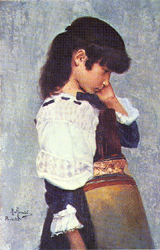
Rodolfo Amoêdo
"Amuada", 1882
|
